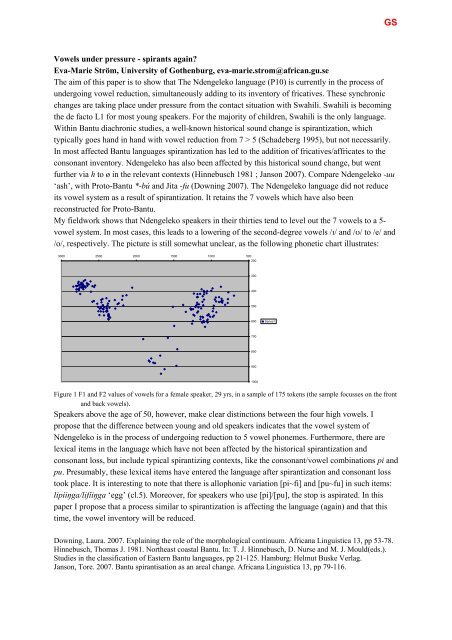here - 5th International Conference on Bantu Languages
here - 5th International Conference on Bantu Languages
here - 5th International Conference on Bantu Languages
You also want an ePaper? Increase the reach of your titles
YUMPU automatically turns print PDFs into web optimized ePapers that Google loves.
Vowels under pressure - spirants again?<br />
Eva-Marie Ström, University of Gothenburg, eva-marie.strom@african.gu.se<br />
The aim of this paper is to show that The Ndengeleko language (P10) is currently in the process of<br />
undergoing vowel reducti<strong>on</strong>, simultaneously adding to its inventory of fricatives. These synchr<strong>on</strong>ic<br />
changes are taking place under pressure from the c<strong>on</strong>tact situati<strong>on</strong> with Swahili. Swahili is becoming<br />
the de facto L1 for most young speakers. For the majority of children, Swahili is the <strong>on</strong>ly language.<br />
Within <strong>Bantu</strong> diachr<strong>on</strong>ic studies, a well-known historical sound change is spirantizati<strong>on</strong>, which<br />
typically goes hand in hand with vowel reducti<strong>on</strong> from 7 > 5 (Schadeberg 1995), but not necessarily.<br />
In most affected <strong>Bantu</strong> languages spirantizati<strong>on</strong> has led to the additi<strong>on</strong> of fricatives/affricates to the<br />
c<strong>on</strong>s<strong>on</strong>ant inventory. Ndengeleko has also been affected by this historical sound change, but went<br />
further via h to ø in the relevant c<strong>on</strong>texts (Hinnebusch 1981 ; Jans<strong>on</strong> 2007). Compare Ndengeleko -uu<br />
‘ash’, with Proto-<strong>Bantu</strong> *-bú and Jita -fu (Downing 2007). The Ndengeleko language did not reduce<br />
its vowel system as a result of spirantizati<strong>on</strong>. It retains the 7 vowels which have also been<br />
rec<strong>on</strong>structed for Proto-<strong>Bantu</strong>.<br />
My fieldwork shows that Ndengeleko speakers in their thirties tend to level out the 7 vowels to a 5vowel<br />
system. In most cases, this leads to a lowering of the sec<strong>on</strong>d-degree vowels /ɪ/ and /ʊ/ to /e/ and<br />
/o/, respectively. The picture is still somewhat unclear, as the following ph<strong>on</strong>etic chart illustrates:<br />
3000<br />
2500<br />
2000<br />
1500<br />
1000<br />
Figure 1 F1 and F2 values of vowels for a female speaker, 29 yrs, in a sample of 175 tokens (the sample focusses <strong>on</strong> the fr<strong>on</strong>t<br />
and back vowels).<br />
Speakers above the age of 50, however, make clear distincti<strong>on</strong>s between the four high vowels. I<br />
propose that the difference between young and old speakers indicates that the vowel system of<br />
Ndengeleko is in the process of undergoing reducti<strong>on</strong> to 5 vowel ph<strong>on</strong>emes. Furthermore, t<str<strong>on</strong>g>here</str<strong>on</strong>g> are<br />
lexical items in the language which have not been affected by the historical spirantizati<strong>on</strong> and<br />
c<strong>on</strong>s<strong>on</strong>ant loss, but include typical spirantizing c<strong>on</strong>texts, like the c<strong>on</strong>s<strong>on</strong>ant/vowel combinati<strong>on</strong>s pi and<br />
pu. Presumably, these lexical items have entered the language after spirantizati<strong>on</strong> and c<strong>on</strong>s<strong>on</strong>ant loss<br />
took place. It is interesting to note that t<str<strong>on</strong>g>here</str<strong>on</strong>g> is alloph<strong>on</strong>ic variati<strong>on</strong> [pi~fi] and [pu~fu] in such items:<br />
lipíiŋga/lifíiŋga ‘egg’ (cl.5). Moreover, for speakers who use [pi]/[pu], the stop is aspirated. In this<br />
paper I propose that a process similar to spirantizati<strong>on</strong> is affecting the language (again) and that this<br />
time, the vowel inventory will be reduced.<br />
Downing, Laura. 2007. Explaining the role of the morphological c<strong>on</strong>tinuum. Africana Linguistica 13, pp 53-78.<br />
Hinnebusch, Thomas J. 1981. Northeast coastal <strong>Bantu</strong>. In: T. J. Hinnebusch, D. Nurse and M. J. Mould(eds.).<br />
Studies in the classificati<strong>on</strong> of Eastern <strong>Bantu</strong> languages, pp 21-125. Hamburg: Helmut Buske Verlag.<br />
Jans<strong>on</strong>, Tore. 2007. <strong>Bantu</strong> spirantisati<strong>on</strong> as an areal change. Africana Linguistica 13, pp 79-116.<br />
500<br />
200<br />
300<br />
400<br />
500<br />
600<br />
700<br />
800<br />
900<br />
1000<br />
Series1<br />
GS


